
Solution Overview
The CQ-3780® connectivity solution delivers the
ultimate in IBM® 3780/2780 Bisync/RJE terminal emulation connectivity by
combining the depth and full range of IBM emulation with the simplicity and
ease-of-use of the Windows® Graphical User Interface (GUI). This solution
provides simple and convenient connectivity from any remote or local workstation
or client running a Microsoft® Windows operating system. CQ-3780
is also available for connectivity from any remote or local network server
running a Microsoft Windows server operating system.
CQ-3780 Features
Along with standard 3780/2780 Bisync/RJE terminal emulation, CQ-3780 offers
outstanding features in the following areas:
- Interactive GUI Interface.
The user-friendly interface makes installation, configuration, and use of
CQ-3780 simple and easy to understand. Interface components
such as drop-down menus, customizable toolbars, clearly identified buttons,
and context-sensitive help can be found throughout the solution.
- CQ-File Transfer Options (CQ-FTO) Utility
Program.
CQ-3780 is supplied with the CQ-FTO
utility program for sending and receiving files. The CQ-FTO
program provides easy customization of file transfer settings and procedures
for host site access. CQ created this program so that you can save
multiple file transfer sessions as unique descriptive names that best fit the
on-site terminology for each site or the type of file transfer. File
transfer selections then become easier and clearer to those responsible for
the day-to-day file transfer operations.
- Customizable Features.
The customizable toolbar and floating SmartKey Pad allow users
convenient and quick one button access to scripts, complex commands, and other
programs, such as CQ’s optional productivity
solutions. For example, a button can be setup that condenses a
series of JES commands into a single mouse click. This might be helpful
as a means to have one button queue access. A button may also be easily
setup for one button remote host login access.
- Scripting and Scheduling for Unattended
Operation.
CQ’s scripting language allows automated and unattended CQ-3780
host site communications through customized scripts and scheduling features.
Unattended automation facilities make host site communications more cost
effective than normal attended operation. Most any task can be scheduled
for execution through CQ’s scripting commands. When writing scripts,
script writers can easily trap errors, generate appropriate responses, and
even access convenient pop-up screen messaging when writing scripts. CQ
scripts can also be written to make system calls to the Windows operating
system in order to respond to a variety of communications events. For
assistance in customizing scripts for specific communications needs, CQ’s
knowledgeable Technical Support staff is also available.
- Numerous Connection Options.
CQ-3780 displays its flexibility through its numerous hardware
connection options. Whether communications is from a remote PC
workstation, a mobile laptop computer, or a direct local network connection,
CQ-3780 has a hardware connection solution that will work in any
of these environments as well as many more. Hardware options include
AutoSync™ 2 modems and
CQ-Sync™ PCI adapter cards.
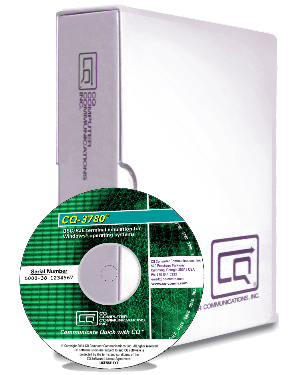 Additional
Technical Features
Additional
Technical Features
- Configurator. CQ’s Configurator program allows users
to quickly and easily set communication options. Most of these options
are set from one screen, the opening CQ Configurator screen.
Users can generally set the necessary options from this screen within a matter
of minutes. The Configurator program can be used to create
configurations for multiple sites that may require a different set of
communications options.
- Interface Screen. An informative Interface screen
appears when terminal emulation occurs with the host. This screen
clearly displays the current status of communications, any OutBound console
data, and any InBound console data. Users can also conveniently scroll
through the data queues from this screen. All of the information is
displayed in a clear, concise manner.
- Printer Support. CQ-3780 supports any laser printer
that is supported by the Windows operating system. Customizable print
features such as the number of lines and columns and page orientation can
easily be setup through the solution. CQ-3780 also
supports the Windows operating system print spooler so the user can print
multiple jobs. Up to eight concurrent printers are also supported by the
solution. The solution also supports older legacy printers for uses that
require raw line prints.
- Data Transmissions. Frame Relay users can specify a large max
data size. Users are not confined to the standard max data sizes used by
other applications. By allowing users to set specific max data sizes,
CQ-3780 takes full advantage of the high throughput rate for Frame
Relay networks.
- CQ Diagnostics. CQ-3780 provides accessible
communications logging features through its audit and trace options.
These features are used for tracking the user’s data transfers and include
time stamps, file send and receive information, and file size information.
- Security Features. CQ-3780 is equipped with numerous
security features. Certain areas of the program are password protected.
The configuration data is decrypted dependent upon the proper entry of the
correct password. Dial-back security is also supported.
- Fast Batch File Transfers. CQ’s 3780 solution supports
repeated character compression in both directions. Both inbound and
outbound data are compressed making batch file transfers extremely quick.
Files can be sent as console, printer, card reader, or binary data at sizes up
to 4096 bytes.
- Automated File Distribution. CQ-3780 may be placed on
a network with any number of workstations and can be used to send and receive
files as commanded by any network user. Network users can also be
notified when files have been received.
- 3780 ASCII Terminal Emulation. For host communications, CQ’s
3780 solution supports 3780 ASCII terminal emulation.
- Automatic Features. CQ’s 3780 solution provides auto-dialing
and auto-answer support for a wide range of modems and devices. Also,
CQ’s automatic file naming feature allows users to accept an unknown number of
files by naming each received file with a unique extension.
- ASCII/EBCDIC Translation. All incoming data is automatically
translated from EBCDIC to ASCII and all outgoing data from ASCII to EBCDIC.
The translation occurs according to CQ’s internal translation tables.
Users can also customize their own tables to perform special character
translations. For binary data transfers, automatic translation can be
disabled.
- CQ Access Point
Agreement (CQ’s Annual License Activation and Software Maintenance
Agreement). CQ recognizes the importance of providing our customers with
access to comprehensive technical services and support. CQ also feels that
access to product upgrades and updates is an integral part of an
organization’s overall software deployment strategy. With this in mind, CQ
provides the CQ Access Point agreement to its customers. With each
license acquisition, you receive annual license activation as well as access
to the product upgrade and technical support features of Software Maintenance.
Sample Screen Shots
CQ provides our web page visitors with a quick look at several sample
CQ-3780 screens.
CQ Configurator Screen
This screen displays the settings required by most users to complete
configuration. Some users may need to access the Advanced Options
screen (see below) for further customization.
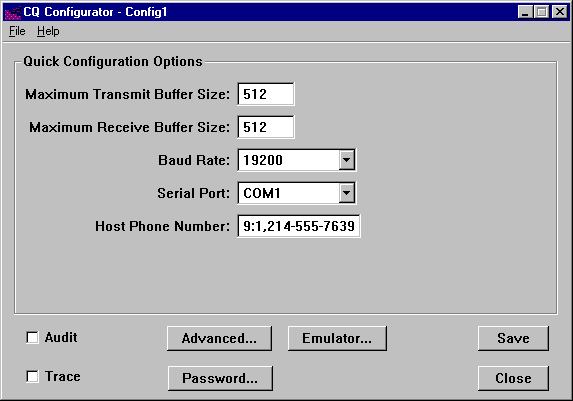
Advanced Options Screen
Most options that are necessary for host communications can be set through the
CQ Configurator screen (see above). In some cases, it may be
necessary to set some of the options that do not appear on the CQ
Configurator screen from within the various folder tab options (Dialing,
Modem, etc.) located on the Advanced Options screen.
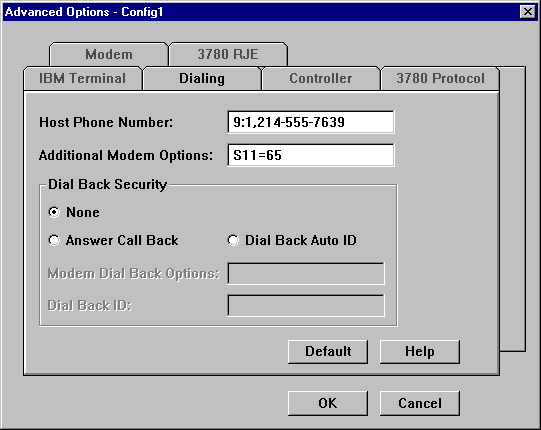
Interface Screen
The Interface screen appears in RJE In/Out Bound mode when you are
connected with the host.
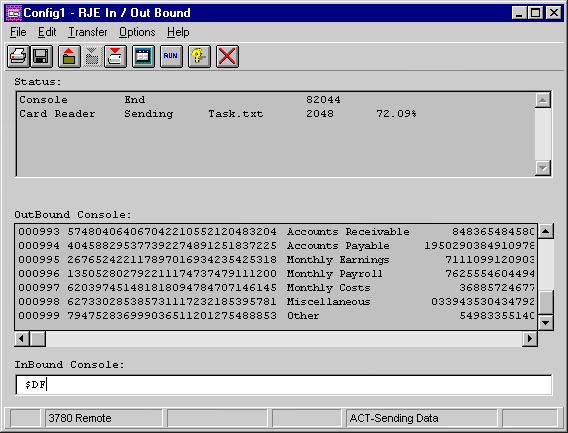
Receive Data Screen
From this screen, you can change the settings associated with receiving data
from the host.
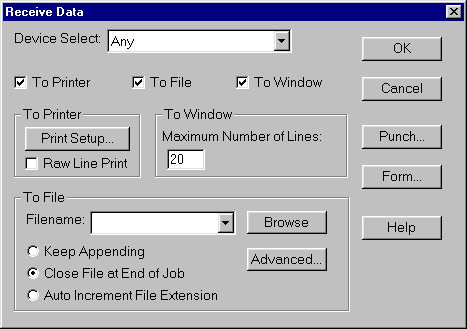
Receive Data - Form Options Screen
From this screen, you can change the settings associated with receiving form
data.
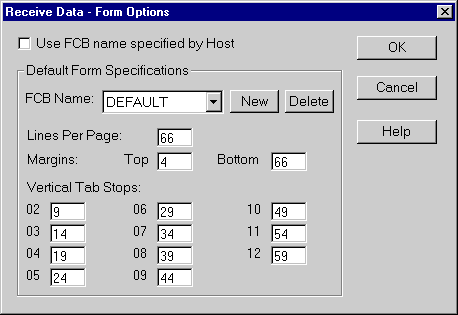
CQ Script Screen
From this screen, you can view a CQ script as it runs.
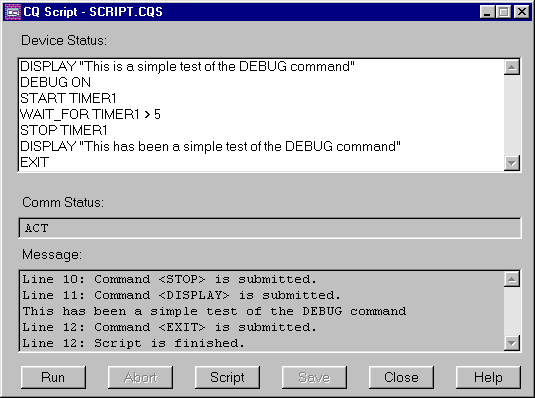
Customize Toolbar Screen
From this screen, you can customize the toolbar that appears within the
Emulator screen by adding, editing, or deleting toolbar buttons.

Hardware and Connection Options
To communicate with a mainframe computer using CQ-3780, the PC
or notebook computer running CQ-3780 must be equipped with the
proper hardware. In most cases, the host site almost always determines the
connection option for communications between remote or local workstations and
the mainframe computer. For example, the host site might help to determine
the speed (baud rate) of the connection as the host site ultimately controls
this option. Other factors, such as port availability, type of port, and
other factors, are controlled by the workstation that is connecting with the
mainframe.
Each CQ-3780 connectivity solution is equipped with a primary
communications driver that is based on the user’s hardware configuration.
Hardware configuration options include AutoSync 2
modems and CQ-Sync PCI
adapter cards. The type
of connection can be further divided into remote or local connections from a
stand-alone workstation. CQ-3780 is as flexible as your
needs are, so contact CQ if you have any questions
about which solution is right for your application.
| Quick Jump to Connection
Option...
|
Hayes™ OPTIMA™ Modem (with AutoSync 2)
Before
the AutoSync technology, remote PC-to-host communications users were required to
install and configure numerous hardware components on the workstation including
an internal synchronous adapter card, cable, external synchronous modem, and, in
some cases, additional hardware such as a switch box.
In the 1980’s, CQ co-developed and engineered the original AutoSync
technology with Hayes Microcomputer Products, Inc. The AutoSync technology
allows synchronous PC-to-host users to eliminate additional hardware that was
previously required for host connectivity. In AutoSync mode, the modem
automatically performs an internal asynchronous-to-synchronous conversion, thus
permitting easy PC-to-host communications without any additional hardware
required!
The AutoSync 2 feature automatically performs the
sync/async conversion that is necessary for synchronous host communications over
analog dial-up lines at speeds up to 33.6 Kbps. This feature is available
in the OPTIMA line of external and internal modems that are currently
manufactured by Zoom® Telephonics, Inc. PCMCIA versions of the OPTIMA
modem are available directly through CQ.
CQ-Sync100™ PCI Adapter Card
This internal 32-bit synchronous adapter card
allows PC users to connect remotely to host computers over analog dial-up or
dedicated leased lines at speeds up to 33.6 Kbps. The card uses an RS-232
cable to connect to an external synchronous modem.
CQ-Sync 200™ PCI and CQ-Sync300™ PCI High-Speed Adapter Cards
These internal 32-bit high-speed synchronous adapter cards allow PC users to
connect remotely to host computers through two different hardware
configurations. The CQ-Sync200 PCI
adapter card uses an RS-232 cable to connect to an external synchronous modem or
high-speed device (CSU/DSU, Router, etc.). The
CQ-Sync300 PCI adapter card uses a V.35 cable.
- The first configuration uses the adapter cards to communicate over analog
dial-up lines, dedicated leased lines, ISDN lines, T1/Fractional T1 leased
lines, or other connection lines at speeds between 2400 bps and 128 Kbps.
The CQ-Sync PCI card is installed at the remote workstation and
is then connected to an external synchronous modem or high-speed device.
- The second configuration uses the adapter cards and high-speed devices to
communicate through a local router over routed networks.
Local Direct Connection
CQ-3780 allows direct host connectivity through a local
workstation. This type of connection utilizes a CQ-Sync PCI
adapter card to perform the direct
connection to the host.
Communications Options
- Remote analog dial-up, dedicated leased line, ISDN, T1/Fractional T1, and
other connection lines.
- Remote routed network (Frame Relay, etc.) via serial connections.
- Local direct connections.
- Many other connections types for various communications options.
Contact CQ for additional information.
Specifications
Workstation (PC, Notebook, etc.) or
Server Requirements
- Processor. CQ recommends an Intel
Pentium/Celeron family processor, AMD K6/Athlon/Duron family processor, or
compatible processor with a speed of at least 1.0 GHz or higher.
- Memory. CQ recommends at least 128 MB or
higher of RAM.
- Hard Drive. CQ recommends at least 10 MB of
available hard disk space.
- Operating System. The workstation’s operating system
must be a Windows operating system (i.e., Windows 95, Windows
98, Windows NT, Windows 2000, Windows XP, etc.). CQ-3780
for servers users must be using Windows NT Server 4.0, Windows
2000 Server, or Windows Server 2003.
- Peripherals. The monitor, keyboard, mouse, and
CD ROM drive must be compatible with the current operating
system.
- Other Requirements. Other communications hardware (modem,
adapter card, etc.), available slots and/or ports, and available settings may
also be required depending on the connection type. Also be aware that
the type of hardware used for your connection may affect operating system
compatibility. Contact CQ for additional information.
Host End Requirements
- The host computer must be an IBM mainframe, midrange, or compatible host
with an optional Front End Processor (FEP). The systems supported
include JES2, JES3, POWER, and other environments that support IBM’s RJE
option.
- CQ-3780 may also be used to communicate with other mainframe
sites supporting IBM’s 3780 communications protocol, including banks,
insurance companies, and financial services companies. Additionally,
CQ-3780 may be used for PC to PC communications.
 Top of Page
Top of Page


 Additional
Technical Features
Additional
Technical Features





